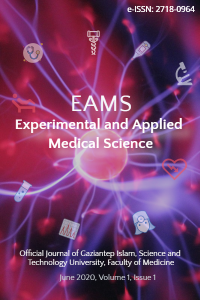Comparison of the acute and cumulative dose administrations in doxorubicin-induced hepatotoxicity via evaluation of the histopathological changes and inflammation in rats
Doksorubisin, hepatotoksisite, enflamasyon, karaciğer hasarı
Comparison of the acute and cumulative dose administrations in doxorubicin-induced hepatotoxicity via evaluation of the histopathological changes and inflammation in rats
doxorubicin, hepatotoxicity, inflammation, liver damage,
___
- Arnon J, Meirow D, Lewis-Roness H, Ornoy A. Genetic and teratogenic effects of cancer treatments on gametes and embryos. Hum Reprod Update. 2001;7(4):394-403.
- Pugazhendhi A, Edison T, Velmurugan BK, Jacob JA, Karuppusamy I. Toxicity of Doxorubicin (Dox) to different experimental organ systems. Life Sci. 2018;200:26-30.
- Yokochi T, Robertson KD. Doxorubicin inhibits DNMT1, resulting in conditional apoptosis. Mol Pharmacol. 2004;66(6):1415-20.
- Ahmed F, Urooj A, Karim AA. Protective effects of Ficus racemosa stem bark against doxorubucin-induced renal and testicular toxicity. Pharmacogn Mag. 2013;9(34):130-4.
- Malekinejad H, Janbaz-Acyabar H, Razi M, Varasteh S. Preventive and protective effects of silymarin on doxorubicin-induced testicular damages correlate with changes in c-myc gene expression. Phytomedicine. 2012;19(12):1077-84.
- Miyata S, Takemura G, Kosai K, Takahashi T, Esaki M, Li L, et al. Anti-Fas gene therapy prevents doxorubicin-induced acute cardiotoxicity through mechanisms independent of apoptosis. Am J Pathol. 2010;176(2):687-98.
- Omobowale TO, Oyagbemi AA, Ajufo UE, Adejumobi OA, Ola-Davies OE, Adedapo AA, et al. Ameliorative Effect of Gallic Acid in Doxorubicin-Induced Hepatotoxicity in Wistar Rats Through Antioxidant Defense System. J Diet Suppl. 2018;15(2):183-96.
- Trivedi PP, Tripathi DN, Jena GB. Hesperetin protects testicular toxicity of doxorubicin in rat: role of NFkappaB, p38 and caspase-3. Food Chem Toxicol. 2011;49(4):838-47.
- Noronha IL, Niemir Z, Stein H, Waldherr R. Cytokines and growth factors in renal disease. Nephrol Dial Transplant. 1995;10(6):775-86.
- He Y, Yang Z, Li J, Li E. Dexmedetomidine reduces the inflammation and apoptosis of doxorubicin-induced myocardial cells. Exp Mol Pathol. 2020;113:104371.
- Zhang S, You ZQ, Yang L, Li LL, Wu YP, Gu LQ, et al. Protective effect of Shenmai injection on doxorubicin-induced cardiotoxicity via regulation of inflammatory mediators. BMC Complement Altern Med. 2019;19(1):317.
- Nordgren KKS, Wallace KB. Disruption of the Keap1/Nrf2-Antioxidant Response System After Chronic Doxorubicin Exposure In Vivo. Cardiovasc Toxicol. 2020;20(6):557-70.
- Hinkley JM, Morton AB, Ichinoseki-Sekine N, Huertas AM, Smuder AJ. Exercise Training Prevents Doxorubicin-induced Mitochondrial Dysfunction of the Liver. Med Sci Sports Exerc. 2019;51(6):1106-15.
- Shivakumar P, Rani MU, Reddy AG, Anjaneyulu Y. A study on the toxic effects of Doxorubicin on the histology of certain organs. Toxicol Int. 2012;19(3):241-4.
- Mansouri E, Jangaran A, Ashtari A. Protective effect of pravastatin on doxorubicin-induced hepatotoxicity. Bratisl Lek Listy. 2017;118(5):273-7.
- Karabulut D, Ozturk E, Kuloglu N, Akin AT, Kaymak E, Yakan B. Effects of vitamin B12 on methotrexate hepatotoxicity: evaluation of receptor-interacting protein (RIP) kinase. Naunyn Schmiedebergs Arch Pharmacol. 2020;393(12):2473-80.
- Sönmez MF, Ozdemir Ş, Guzel M, Kaymak E. The ameliorative effects of vinpocetine on apoptosis and HSP-70 expression in testicular torsion in rats. Biotech Histochem. 2017;92(2):92-9.
- Bayatli F, Akkus D, Kilic E, Saraymen R, Sonmez MF. The protective effects of grape seed extract on MDA, AOPP, apoptosis and eNOS expression in testicular torsion: an experimental study. World J Urol. 2013;31(3):615-22.
- Karabulut D, Ozturk E, Kaymak E, Akin AT, Yakan B. Thymoquinone attenuates doxorubicin-cardiotoxicity in rats. J Biochem Mol Toxicol. 2020:e22618.
- Sonmez MF, Karabulut D, Kilic E, Akalin H, Sakalar C, Gunduz Y, et al. The effects of streptozotocin-induced diabetes on ghrelin expression in rat testis: biochemical and immunohistochemical study. Folia Histochem Cytobiol. 2015;53(1):26-34.
- Sonmez MF, Kilic E, Karabulut D, Cilenk K, Deligonul E, Dundar M. Nitric oxide synthase in diabetic rat testicular tissue and the effects of pentoxifylline therapy. Syst Biol Reprod Med. 2016;62(1):22-30.
- Öztürk E, Kaymak E, Akin AT, Karabulut D, Ünsal HM, Yakan B. Thymoquinone is a protective agent that reduces the negative effects of doxorubicin in rat testis. Hum Exp Toxicol. 2020;39(10):1364-73.
- Kaymak E, Akin AT, Tufan E, Başaran KE, Taheri S, Özdamar S, et al. The effect of chloroquine on the TRPC1, TRPC6, and CaSR in the pulmonary artery smooth muscle cells in hypoxia-induced experimental pulmonary artery hypertension. J Biochem Mol Toxicol. 2020:e22636.
- Wang H, Wei W, Wang NP, Gui SY, Wu L, Sun WY, et al. Melatonin ameliorates carbon tetrachloride-induced hepatic fibrogenesis in rats via inhibition of oxidative stress. Life Sci. 2005;77(15):1902-15.
- Okuyama H, Nakamura H, Shimahara Y, Araya S, Kawada N, Yamaoka Y, et al. Overexpression of thioredoxin prevents acute hepatitis caused by thioacetamide or lipopolysaccharide in mice. Hepatology. 2003;37(5):1015-25.
- Li J, Li L, Li X, Wu S. Long noncoding RNA LINC00339 aggravates doxorubicin-induced cardiomyocyte apoptosis by targeting MiR-484. Biochem Biophys Res Commun. 2018;503(4):3038-43.
- El-Sayed EM, Mansour AM, El-Sawy WS. Protective effect of proanthocyanidins against doxorubicin-induced nephrotoxicity in rats. J Biochem Mol Toxicol. 2017;31(11).
- Hozayen W. Effect of hesperidin and rutin on doxorubicin induced testicular toxicity in male rats. International Journal of Food Sciences and Nutrition. 2012;1:31-42.
- Jiang W, Guo H, Su D, Xu H, Gu H, Hao K. Ameliorative effect of Magnesium Isoglycyrrhizinate on hepatic encephalopathy by Epirubicin. Int Immunopharmacol. 2019;75:105774.
- Swardfager W, Lanctôt K, Rothenburg L, Wong A, Cappell J, Herrmann N. A meta-analysis of cytokines in Alzheimer's disease. Biol Psychiatry. 2010;68(10):930-41.
- ISSN: 2757-847X
- Başlangıç: 2020
- Yayıncı: Gaziantep İslam Bilim ve Teknoloji Üniversitesi
Fatigue, Exercise Tendency and Physical Activity Behaviour of Female Patients with Breast Cancer
Sabriye ERCAN, Ahsen OĞUL, Murat KOÇER, Esma ARSLAN, Ferdi BAŞKURT, Cem ÇETİN
Aromatase, Estrogen and Male Reproduction: a Review
Emin KAYMAK, Ayşegül Burçin YILDIRIM
Ali AKIN, Emin KAYMAK, Derya KARABULUT, Züleyha DOĞANYİĞİT, Tayfun CEYLAN, Ayşe TOLUK, Saim ÖZDAMAR
Morphometric Examination of the Proximal Femur in the Hip Joint
Adem TOKPINAR, Seher YİLMAZ, Adem TOKPINAR, Şükrü ATEŞ, Mücahit KANDUR, Mehtap NİSARİ
Effect of Curcumin on Liver Damage Caused by Cisplatin in Rats
